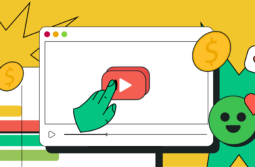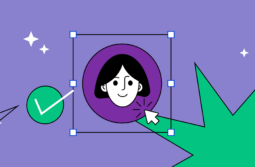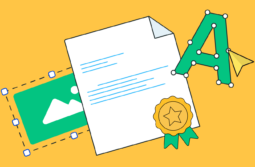A popular rule says that a person needs 10,000 hours of practice to become good at some subject. However, this rule will hardly fit creators designing online courses: planning even a 50-hour course requires significant time and resource investments, not to mention the costs needed during the production and post-production stages.
So, the natural question such entrepreneurs will ask is: what’s the ideal length for the online course? How long should you make each section? Each lesson or video?
In this post, we’ll talk about online course duration to help you identify the optimal length for your eLearning product. We’ll also review the key aspects that impact a course length, some of the best practices for eLearning projects’ duration, and introduce a great tool that may help you simplify the process of online learning course creation.
Content:
What is the perfect length for an online course?
To start with, the core idea of any online course is that it should address all the learning objectives. So, its overall duration will depend on how much time is required to introduce the course’s material and help students effectively master it.
At the same time, when setting up the online course, you’d surely want to make it as profitable as possible. The course duration matters here too.
The most profitable course length is considered to be 10-25 hours, with a revenue of around $10,000. To compare, courses with a 5-10 hours duration are about 75% profitable and bring much more revenue than eLearning courses of over 100+ hours (up to $6,000 income).
Thus, it becomes more than obvious: there’s no one-size-fits-all course length that ideally works for any eLearning product. However, this doesn’t mean that you can’t determine the perfect length of your online course. In the next paragraph, we’ll discuss the key points that can help you figure out the most effective and profitable course duration.
Criteria for estimating the optimal course length
There is no right or wrong answer when it comes to determining the perfect length of a course. Typically, it strongly depends on many factors, including your audience, topic, and goals.
To help you better understand the most suitable course length for your eLearning project, let’s review some essential criteria based on the example of online cooking courses.
Course length criterion #1 Subject’s complexity
The first factor that impacts the course length is the subject matter and complexity of the topic. Depending on how specific the course material is, the overall time needed for its explanation and completion will vary correspondingly.
For instance, if you’re making entry-level cooking courses that cover essential cooking skills and some basic food preparation techniques, your course should be shorter and manageable to complete within a couple of days. On the contrary, the advanced kitchen courses that go deeper into the specifics of a particular cuisine, its history, and a bunch of classic recipes will require at least 5-10 hours of learning.
To estimate the most suitable course length in terms of the subject’s complexity and course type, try to ask yourself: “If I am an entry-level student, how long would it take me to learn this easily and effectively?” This will help you identify the most convenient duration of your courses.
Course length criterion #2 Learning goals
The next factor that matters when figuring out the optimal length for your eLearning course is the end goals it allows achieving. For example, learners who need to master basic skills like quick chopping or veggie blanching will surely look for short-term courses that explain how to do so.
On the contrary, it might take several weeks or even months to explore the specifics of French cuisine, how to make croissants, filet mignon, or coq au vin. Everything depends on your students’ goals and the possible time these can be achieved.
For a better understanding of the online course length, consider what the final results of the studying are and what goals your potential students will want to achieve at the end. It allows you to calculate the approximate time required to explain everything and learn accordingly.
Course length criterion #3 Target audience
Creating any digital product must always be student-centric, not only to properly determine course duration but also to build a strong marketing strategy and the most effective learning path.
For this purpose, it’s essential to understand the ideal buyer persona for your online course, covering their age, interests, location, challenges, and many other aspects that help you better fit their requirements and target their needs.
At first, considering the ideal student persona for a cooking course is simple: your product should target consumers who want to develop some specific cooking skills. However, going deeper into the details about your end-consumers can help you better target their needs and reach the desired results in the quickest way possible.
Bonus criterion: competitor research
Having learned three criteria that matter for your online course duration, you have probably come up with the specific time required for your eLearning project. Nevertheless, one more trick might come in handy for planning the length of your course — competitor analysis.
Clients want to achieve their learning goals through the subject of study, but none of them will be eager to spend a lifetime learning it. So, before getting started, most students will compare the learning options available to find the most efficient online course in the ratio of time and value, which might make your product stand out on the market.
To be able to provide an ultimate learning product for a certain subject or niche, you should always aim for a balance between time efficiency and thoroughness, which keeps you abreast with the regular market analysis.
So, before you start planning and creating content for your online course, always check the competitors within the same area to determine the ideal course length. Moreover, we recommend checking out different online courses to understand your topic better and identify its popularity within a particular niche. For example, most online cooking courses include videos from 1.5 to 6 hours on Udemy, 2 to 15 hours on FutureLearn, and 30 minutes to 2 hours on Skillshare.
How long should videos for your online course be?
Regardless of how deep you’ll go into the course subject, it’s critical to structure the material in short-length portions to keep your students engaged and the studying process effective.
According to SumoMe, the average engagement rate for videos up to two minutes is nearly 70%, gradually decreasing to 40% for 20-minute-long content. Additionally, the engagement rate is out at a point of over 50% for videos between six minutes and 20 minutes.
Key takeaway: If you’re considering short-form content for your online courses, ensure it fits below two minutes. However, if you’re considering a longer course with a significant count of video content, it makes sense to keep it under 12 minutes, as it won’t affect the student’s engagement.

However, there is also a traditional opinion on setting up the online course with videos that last between 15 and 30 minutes. These estimations are based on multiple factors, such as psychological research, specific content patterns, and, more often than not, gut feeling.
Some experts also suggest considering bigger chunks of up to 1.5 hours to provide a comprehensive overview of the subject. This timing works best for adult audiences looking for deep immersion into the topic.
Key takeaway: If you’re considering a complex online course with an in-depth topic overview, it’s also possible to introduce content in bigger chunks, with a max limit of 90 minutes.
As you can see, there is no ideal duration for your course videos. The final decision still depends on your project’s specifics, course structure, and target audience.
Best practices for ensuring the perfect course length
Apart from the criteria that impact course duration and recommended duration of video content, it’s also good to use some actionable tips that can improve the quality of your eLearning product.
Chunk your eLearning content
There is no secret that learning any content in small, digestible chunks is much easier and more effective compared to a comprehensive course. According to The Health Board, the average attention span in adults varies between 15 to 20 minutes, so most creators chunk their content into separate modules up to 20 min long.
Also known as YouTube learning or microlearning, this practice is highly popular due to the learning flexibility and more efficient maintenance offered. Moreover, course chunking helps learners better understand the learning milestones and prioritize the material according to their learning objectives.
The Cooking 101: Kitchen Basics to Advanced course is an excellent example of structuring the content into small chunks of information.
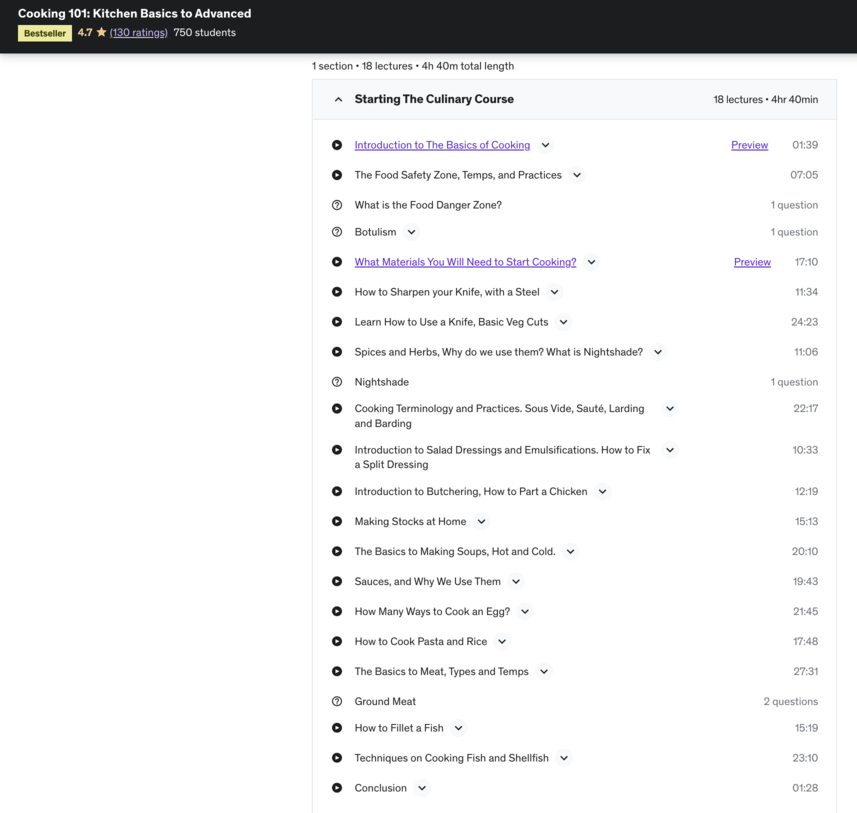
Help students retain knowledge
Ebbinghaus’s research has uncovered that learners will forget an average of 90% of what they have learned within the first seven days. However, there are some great ways to overcome the forgetting curve while enhancing the quality of your online course:
- reinforce the training regularity;
- improve the clarity of the material explained;
- make your content relevant to each student;
- enhance the learners’ engagement.
Reinforcing the course knowledge affects not only the course structure but also the online course length. It is a great way to enhance your eLearning product’s interactivity, efficiency, and value, making it more competitive and valuable for customers.
For example, most courses on Coursera offer practical exercises to help students reinforce the knowledge acquired and memorize it.
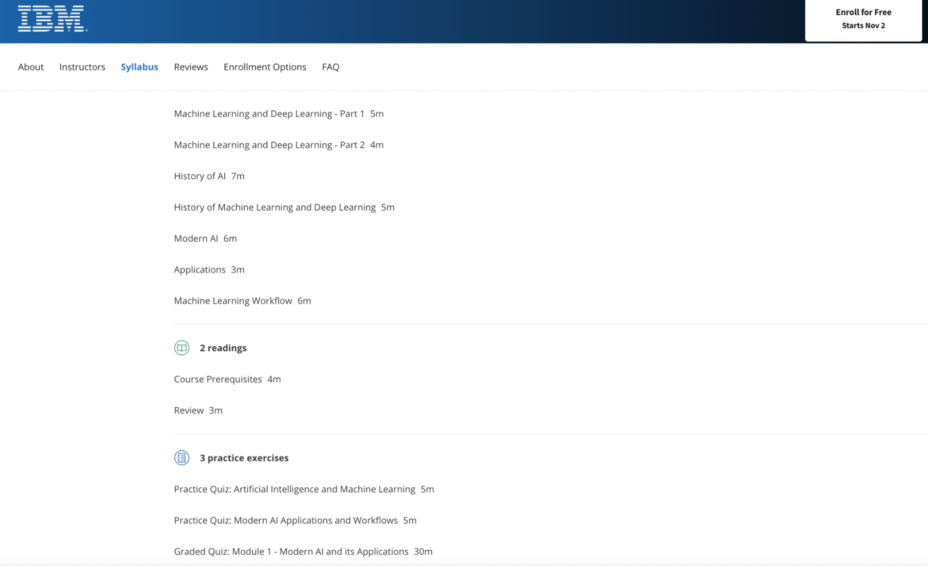
Focus on your learners’ needs
Most online eLearning courses are not confined by geography or time, which adds more flexibility to the educational environment learners use and the overall time they can dedicate to studying.
Moreover, with nearly all the online courses being self-paced, the time required to cover the topic fully will also depend on the student’s proficiency: advanced or entry-level. This aspect also directly correlates with the question of how long should an online course be.
To effectively create an environment that fits best for your audience, give a try to the following recommendations:
- outline the course value and explain how this knowledge may benefit learners;
- implement intuitive navigation and enable users to navigate the course as they want;
- provide the performance scale to help learners measure their progress;
- add more resources and guides to accelerate the learning process;
- keep the course materials updated and regularly adjust them if necessary.
These simple but efficient tips can help make your course more professional-like and student-centric, which, in turn, will add to its value and conversions.
For example, in Aaron Sorkin’s screenwriting course, learners can access lessons in any order. So they can move with the course at their own pace.
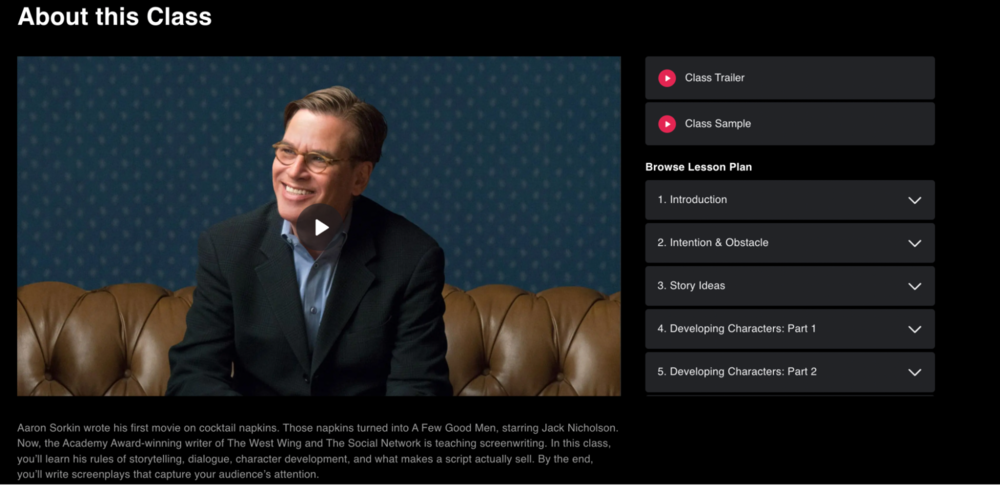
Conclusion
Your ideal course length will strongly depend on your target topic, audience, and objectives. To determine how long should an online course be in your specific case, it’s recommended to consider who your students are and how fast they can master the topic introduced. Basically, this implies deep learning of your customer persona, their needs, and how challenging the material is.
Some may think that a longer online course equals better content quality and a decent conversion rate, but it’s not necessarily true. The key point here is ensuring the course helps your students accomplish their learning goals.
Already know what the ideal length of your online course is? Get started with the online course builder by SendPulse! Our platform offers advanced tools and great features for launching professional courses for any audience and purpose.





![How to Start an Online Course Business [2024 Guide]](https://www.spcdn.org/blog/wp-content/uploads/2024/09/course-business-cover-255x167.png)
